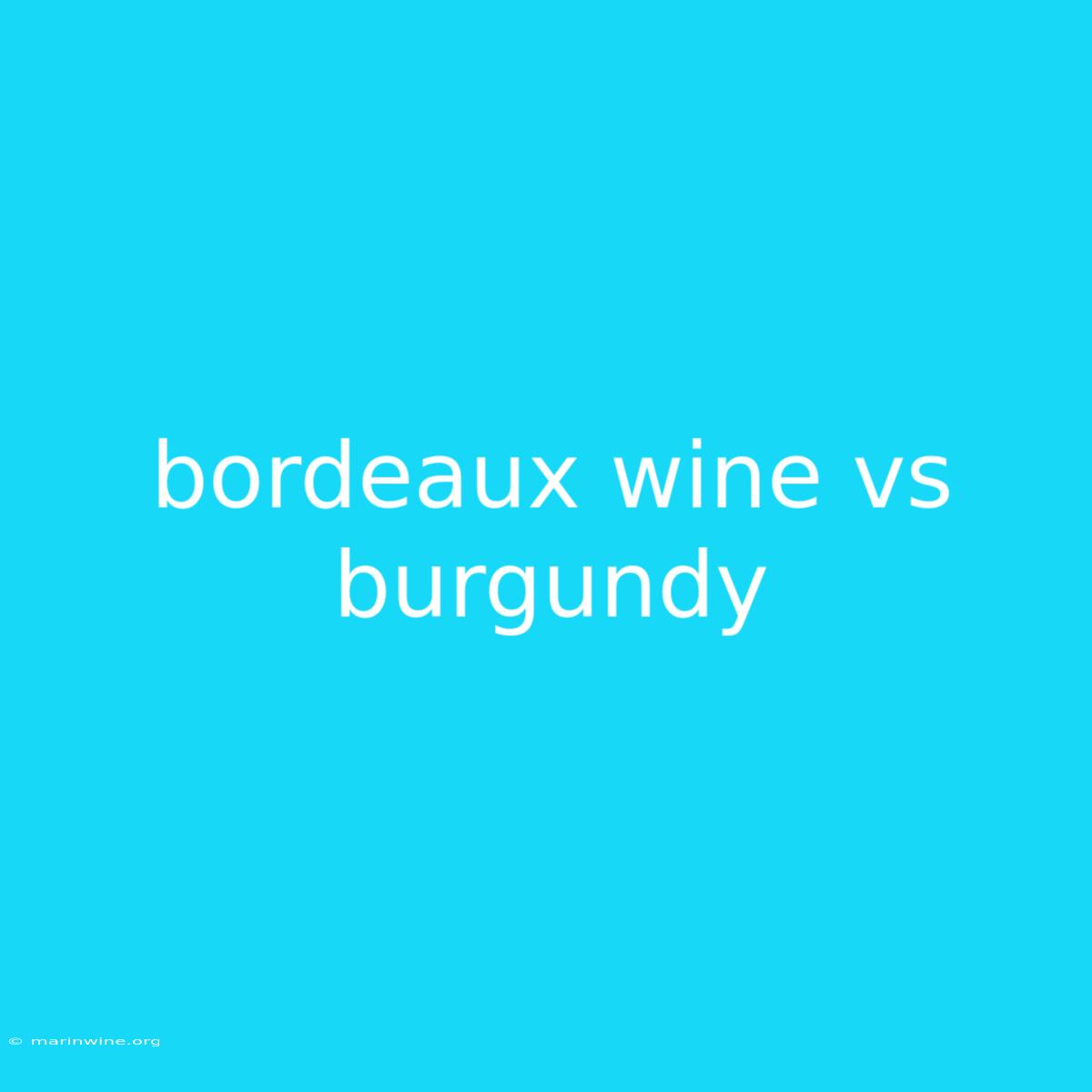Bordeaux vs. Burgundy: Uncorking the Secrets of Two Wine Giants
Have you ever wondered what makes a Bordeaux wine different from a Burgundy? These two French regions are renowned for producing some of the world's most sought-after wines, but they possess distinct characteristics that make them unique. This exploration delves into the fascinating world of these iconic wine regions, unveiling their secrets and helping you understand the nuances that set them apart.
Why It Matters: Understanding the differences between Bordeaux and Burgundy wines can significantly elevate your wine experience. Knowing their unique characteristics allows you to make more informed choices, appreciate their distinct flavors, and navigate the diverse world of French wine with confidence.
Key Takeaways:
| Feature | Bordeaux | Burgundy |
|---|---|---|
| Grape Variety | Cabernet Sauvignon, Merlot, Cabernet Franc, Malbec | Pinot Noir, Chardonnay |
| Style | Full-bodied, complex, structured, age-worthy | Elegant, nuanced, fruit-driven, terroir-focused |
| Region | Bordeaux, France | Burgundy, France |
| Climate | Maritime, warm, with moderate rainfall | Continental, cool, with varying rainfall |
| Terroir | Diverse soils, ranging from gravel to clay | Limestone, clay, and granite soils |
Bordeaux Wine
Introduction: Bordeaux wines are known for their complexity, structure, and potential for aging. They are crafted primarily from a blend of red grape varieties, with Cabernet Sauvignon, Merlot, and Cabernet Franc being the most prominent.
Key Aspects:
- The Blend: Bordeaux wines are rarely made from a single grape variety, instead relying on a blend of grapes to create a more multifaceted flavor profile. Cabernet Sauvignon brings structure and tannins, Merlot adds fruit and softness, and Cabernet Franc contributes elegance and floral notes.
- Terroir: Bordeaux boasts a diverse range of soils, including gravel, clay, and limestone. These different soils contribute distinct characteristics to the wines, influencing their aromas, flavors, and aging potential.
- Aging Potential: Bordeaux wines are renowned for their ability to age gracefully, developing complex aromas and flavors over time. Many Bordeaux wines are designed to be enjoyed after a decade or more of aging, offering a rewarding journey of evolution.
Burgundy Wine
Introduction: Burgundy wines are celebrated for their elegance, finesse, and terroir-driven character. They are primarily made from Pinot Noir for red wines and Chardonnay for whites.
Key Aspects:
- The Single Vineyard: Burgundy wines often focus on the single vineyard or "climat" from which the grapes are sourced. This emphasizes the unique characteristics of each specific plot of land, showcasing the true expression of the terroir.
- The Grape: Pinot Noir is the cornerstone of Burgundy red wines, renowned for its light-bodied nature, delicate flavors, and nuanced complexity. Chardonnay, on the other hand, creates elegant and sophisticated white wines that showcase their distinctive aromas and flavors.
- Terroir-Driven: Burgundy wines are deeply influenced by their terroir. Limestone soils contribute minerality, while clay and granite soils impart different flavor profiles. The region's cool climate also plays a crucial role, influencing the ripening of the grapes and the overall character of the wines.
The Connection Between Bordeaux and Burgundy:
While these two regions may seem vastly different, they share a deep connection to the art of winemaking. Both regions prioritize quality and seek to express the unique characteristics of their respective terroirs. They also have a shared history of winemaking excellence, with centuries of tradition and experience shaping their approach to wine production.
FAQ
Q: Which wine is better, Bordeaux or Burgundy? A: There is no definitive answer to this question. Both Bordeaux and Burgundy produce exceptional wines, each with its own unique qualities. The best wine for you depends on your personal preferences and what you are looking for in a wine.
Q: How much does a bottle of Bordeaux or Burgundy wine cost? A: The price of Bordeaux and Burgundy wines can vary greatly, depending on the producer, vintage, and specific vineyard. From affordable everyday wines to rare and highly sought-after bottles, these regions offer a wide range of pricing options.
Q: Are Bordeaux and Burgundy wines difficult to drink? A: While some Bordeaux and Burgundy wines can be complex and require some experience to fully appreciate, there are also many approachable and easy-drinking options available. Experimenting with different styles and vintages will help you find wines that suit your taste.
Tips for Enjoying Bordeaux and Burgundy Wines:
- Start with lighter-bodied wines: Burgundy wines made from Pinot Noir and Chardonnay can be a good place to start, offering delicate flavors and a smooth mouthfeel.
- Pair with food: Bordeaux and Burgundy wines are excellent accompaniments to various cuisines. Consider pairing Bordeaux with red meats, cheeses, and hearty stews. Burgundy wines can be paired with chicken, fish, and lighter dishes.
- Consider the vintage: Vintage variation plays a crucial role in the quality and character of Bordeaux and Burgundy wines. Researching vintage charts can help you make informed choices.
- Open the bottle early: Bordeaux and Burgundy wines can benefit from some air exposure before drinking. Allow the wine to breathe for a few hours, or decant it to help it open up and reveal its full potential.
Summary:
The world of Bordeaux and Burgundy wines is rich and diverse, offering an extraordinary journey of flavor and discovery. By understanding their distinct characteristics and appreciating their unique terroir, you can elevate your wine experience and unlock the secrets of these iconic wine regions. Whether you prefer the complexity of Bordeaux or the elegance of Burgundy, embark on a journey of exploration and savor the beauty of French wine. Continue your exploration by visiting a local wine shop or attending a wine tasting event to experience these wines firsthand!

